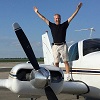09 Jun 2025, 09:18 [ UTC - 5; DST ]
|


|
Page 1 of 1
|
[ 10 posts ] |
|
|
Username Protected
|
Post subject: Re: Williams Int. Engine Air Brake  Posted: Posted: 04 Dec 2015, 15:02 |
|
 |

|
|
 |

Joined: 11/08/12
Posts: 7370
Post Likes: +4834
Location: Live in San Carlos, CA - based Hayward, CA KHWD
Aircraft: Piaggio Avanti
|
|
Username Protected wrote: It's not a substitute for reversers, it's for noise reduction. Ah ha. Cool. (mea culpa, I should've actually read the linked article!  ) Seems like a good idea to me. Increased options to achieve various types of aircraft performance is never a bad thing in my estimation.
_________________
-Jon C.
|
|
| Top |
|
|
Username Protected
|
Post subject: Re: Williams Int. Engine Air Brake  Posted: Posted: 07 Dec 2015, 00:10 |
|
 |

|

|
 |

Joined: 04/26/13
Posts: 21680
Post Likes: +22240
Location: Columbus , IN (KBAK)
Aircraft: 1968 Baron D55
|
|
Username Protected wrote: They also mentioned that this somehow saves fuel and I don't get that at all. If you can descend steeply in a clean configuration with the power back you create a smaller noise footprint and use less fuel. It's all about being able to slam-dunk yourself.
_________________
My last name rhymes with 'geese'.
|
|
| Top |
|
|
Username Protected
|
Post subject: Re: Williams Int. Engine Air Brake  Posted: Posted: 07 Dec 2015, 01:19 |
|
 |

|
|

Joined: 11/06/11
Posts: 465
Post Likes: +129
Company: Southwest Airlines
Location: KGEU
Aircraft: Baron E-55
|
|
Hello Lance, Username Protected wrote: I don't understand the benefit of this idea. The author of the PM article seems to think that flaps and slats are deployed solely to increase drag on approach and doesn't seem to understand that drag isn't the primary goal (if it's a goal at all). And IME the primary noisemaker on a descending jet is the engines, not the aerodynamic noise generated by flaps, slats, and landing gear.
There is a requirement to add drag in final approach so the engine power can be maintained at a high enough level that they will spool up quickly if needed but it's my understanding that this is far less of an issue with modern jets than it was in the past. And maybe this "Air Brake" is really just a way to reduce engine noise in the landing configuration but dispersing the sound but that's not at all clear from the article.
They also mentioned that this somehow saves fuel and I don't get that at all. Two things on this. I will be brief. First, an engine air brake would absolutely have benifits at high altitudes. The new generation 737's cannot deploy flaps above FL200 aerodynamic reasons. The speed brakes on many large jets, including the 737 are just not very effective. Now the Beech 1900 I used to fly had a great air brake, it was the props. Anyone who has flown jets and turbo props knows the difference. Night and day. Second, this would absolutely save fuel. At high altitudes, a large airliner may have to begin the descent profile sometimes over 100nm out. You shorten that profile, you save fuel. Its as simple as that. 
|
|
| Top |
|

|
Page 1 of 1
|
[ 10 posts ] |
|

|
You cannot post new topics in this forum
You cannot reply to topics in this forum
You cannot edit your posts in this forum
You cannot delete your posts in this forum
You cannot post attachments in this forum
|

Terms of Service | Forum FAQ | Contact Us
BeechTalk, LLC is the quintessential Beechcraft Owners & Pilots Group providing a
forum for the discussion of technical, practical, and entertaining issues relating to all Beech aircraft. These include
the Bonanza (both V-tail and straight-tail models), Baron, Debonair, Duke, Twin Bonanza, King Air, Sierra, Skipper, Sport, Sundowner,
Musketeer, Travel Air, Starship, Queen Air, BeechJet, and Premier lines of airplanes, turboprops, and turbojets.
BeechTalk, LLC is not affiliated or endorsed by the Beechcraft Corporation, its subsidiaries, or affiliates.
Beechcraft™, King Air™, and Travel Air™ are the registered trademarks of the Beechcraft Corporation.
Copyright© BeechTalk, LLC 2007-2025
|
|
|
|



